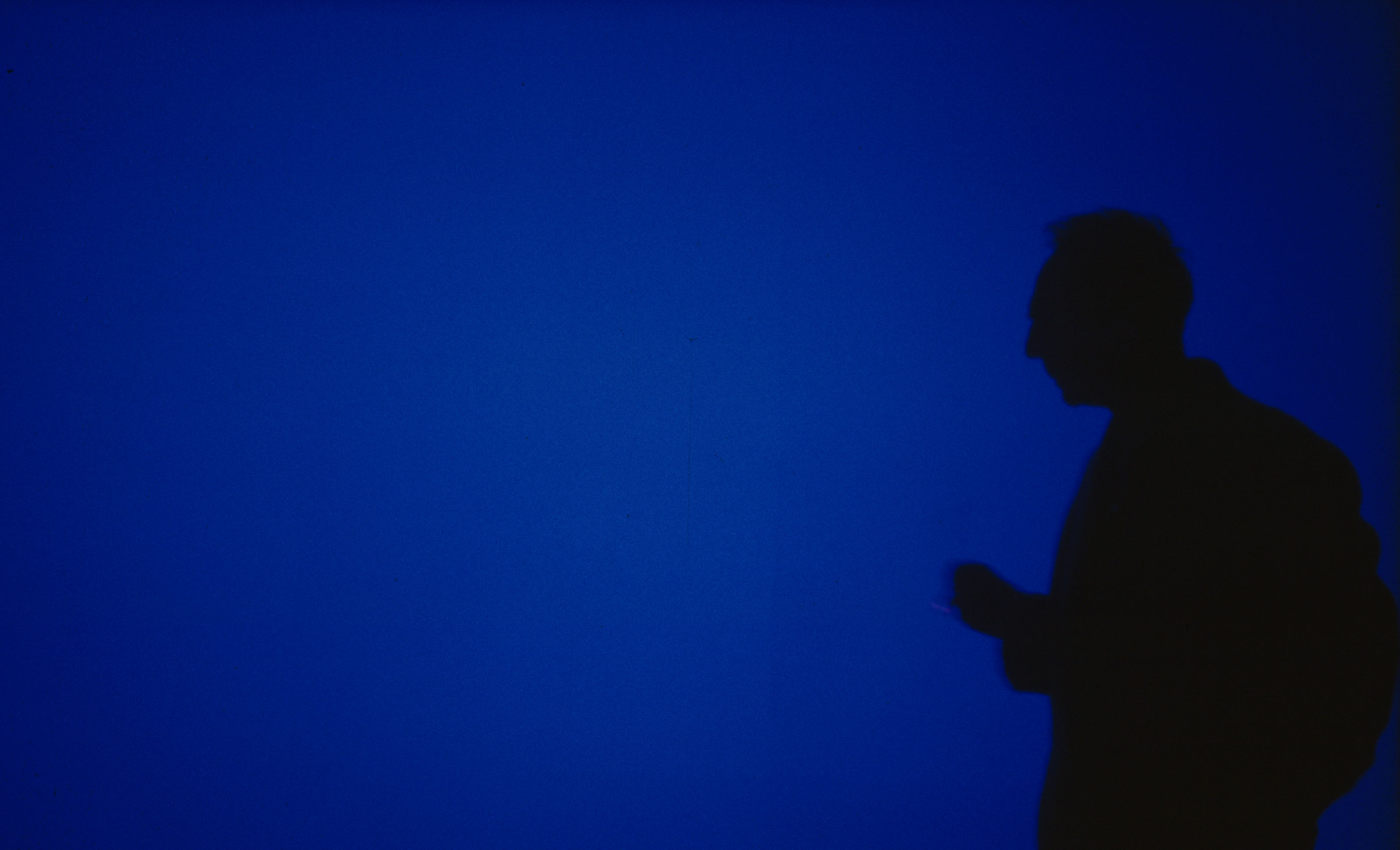Full price: 9 euros
Discounted price: 7 euros
Member price: 5 euros
Derek Jarman, Blue, 1993
35mm, colour, surround sound, 79 min, digitalised
Courtesy Basilisk Communications. Photo Liam Daniel
Alongside the exhibition Derek Jarman – Dead Souls Whisper (1986-1993) at the Le Crédac Contemporary Arts Centre in Ivry, and in conjunction with the Paris Autumn Festival, the Bourse de Commerce is hosting two evenings of projections and concerts in homage to Derek Jarman (1942–1994) and his film Blue (1993).
British composer Simon Fisher Turner, a close collaborator of Derek Jarman’s and the principal composer of the soundtrack for Blue, will perform two reinterpretations live: Blue and Deep Blue.
On 1 December, World AIDS Day, the entire screenplay of Blue will be read out by artist Lili Reynaud Dewar and comedian Yves-Noël Genod, accompanied by Simon Fisher Turner, French pianist David Sanson and French visual artist and musician Rainier Lericolais.
On 2 December, Simon Fisher Turner will perform a live elec-tronic and experimental reinterpretation of the film titled Deep Blue, together with Swedish composer Klara Lewis, British cellist Lucy Railton and British pianist Steve Nieve accompanied by a free reading of the screenplay of Blue by Lili Kim and American artist and writer Black Sifichi.
Derek Jarman
As an artist, director, screenwriter, musician, fan of drag and music hall, and gay rights activist, Derek Jarman (1942–1994) left a significant mark at a very specific moment in British and European culture.
In 1986, Derek Jarman was diagnosed as HIV-positive, a fact he made public, a bold and unprecedented decision at the time that helped put a face to the illness. Jarman became a powerful, subversive, and militant advocate for LGBTQI+ communities and people living with AIDS. Together with Peter Tatchell and Jimmy Somerville, he founded the direct action group OutRage! in 1990. He became a member of the Gay Liberation Front and participated actively in the debates and dialogues within ACT UP.
Simon Fisher Turner
Simon Fisher Turner is renowned for his film soundtrack work which started in collaboration with Derek Jarman, for whom he scored many feature films – from Caravaggio (1986), through to Jarman’s final work Blue (1993). Caravaggio (1986) began a long relationship with the BFI, and more recently Fisher Turner com-posed the score for restorations of three silent films, Un Chant d’amour, dir. Jean Genet (1950), The Great White Silence, dir. Herbert Ponting (1924) and The Epic of Everest dir. Captain John Noel (1924), winning a prestigious Ivor Novello Award for this last one.
Blue (1993)
Derek Jarman directed the film Blue (1993) despite having lost his eyesight almost entirely. Considered one of his masterpieces, the film projects a deep, uniform blue for 74 minutes. In the catalogue for the Le Crédac exhibition (édition Sémiose, 2021), Claire Le Restif explains: “In Blue, Jarman immerses viewers in a meditative experience very similar to what he himself was living through. He asked viewers to listen, to rediscover themselves through words, sounds, and noises, and the reading of his own journal about his illness and his blindness [read aloud by the voices his friends Tilda Swinton, John Quentin, and Nigel Terry]. The soundtrack composed by Simon Fisher Turner contributes to the beauty of this depthless field that verges on the mystical. This is both his last film and his last painting, the work that most resembles the oeuvre of the esoteric artist Yves Klein, who advocated for dematerialising painting by removing as much of its affect as possible. Here there is no image, just the colour blue at which one stares and in which one loses oneself, because the body’s materiality has vanished .”
« Derek Jarman – Dead Souls Whisper (1986-1993) » au Crédac
The exhibition Derek Jarman – Dead Souls Whisper (1986-1993), on show until 19 December at the Crédac, celebrates the artist’s political and artistic stances.
It features three of his Super 8 films produced in the mid-1970s and sixty of his paintings and assemblages made from the time of his HIV-positive diagnosis until his death in 1986. This period coincides with the creation of his famous garden at Prospect Cottage in Dungeness, Kent, which represented a kind of therapy for him, a metaphor of his fierce struggle to stay alive. His final series, titled Queer paintings (1992), focused on the media’s homophobic treatment of the HIV-AIDS. Words are embedded in the paint: Spread the Plague, Tragedy, Positive, Dead Angels, their wavelength ruining the surface.
A considerable part of the exhibition is devoted to the series concerning alchemy, assemblage, and the collection of objects found on the beach in Dungeness. The erasing of the body’s own materiality is also present: Blue, Derek Jarman’s final work, concludes the visit. This exhibition in homage to Derek Jarman may be considered a memorial, because a good number of the works on show are devoted to the AIDS epidemic.
This exhibition was co-produced with the Paris Autumn Festival.
credac.fr
festival-automne.com
courtesy & (c) Basilisk Communications Foundation

